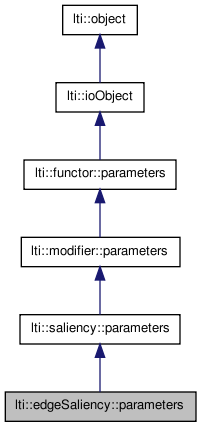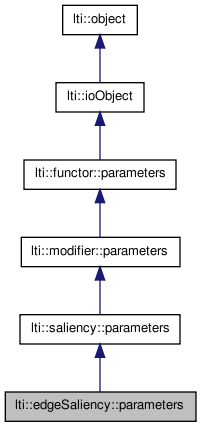

|
latest version v1.9 - last update 10 Apr 2010 |
|
the parameters for the class edgeSaliency More...
#include <ltiEdgeSaliency.h>


Public Member Functions | |
| parameters () | |
| parameters (const parameters &other) | |
| ~parameters () | |
| const char * | getTypeName () const |
| parameters & | copy (const parameters &other) |
| virtual functor::parameters * | clone () const |
| virtual bool | write (ioHandler &handler, const bool complete=true) const |
| virtual bool | read (ioHandler &handler, const bool complete=true) |
Public Attributes | |
| float | couplingCenter |
| float | couplingNeighbour |
| float | initialSigma |
| int | iterations |
| float | rho |
| float | gamma |
| bool | normalise |
| bool | binarise |
| curvationType | curvationTable |
the parameters for the class edgeSaliency
| lti::edgeSaliency::parameters::parameters | ( | ) |
default constructor
Reimplemented from lti::saliency::parameters.
| lti::edgeSaliency::parameters::parameters | ( | const parameters & | other | ) |
copy constructor
Reimplemented from lti::saliency::parameters.
| lti::edgeSaliency::parameters::~parameters | ( | ) | [virtual] |
destructor
Reimplemented from lti::functor::parameters.
| virtual functor::parameters* lti::edgeSaliency::parameters::clone | ( | ) | const [virtual] |
returns a pointer to a clone of the parameters
Reimplemented from lti::saliency::parameters.
| parameters& lti::edgeSaliency::parameters::copy | ( | const parameters & | other | ) |
copy member
Reimplemented from lti::saliency::parameters.
| const char* lti::edgeSaliency::parameters::getTypeName | ( | ) | const [virtual] |
returns name of this type
Reimplemented from lti::saliency::parameters.
| virtual bool lti::edgeSaliency::parameters::read | ( | ioHandler & | handler, | |
| const bool | complete = true | |||
| ) | [virtual] |
write the parameters in the given ioHandler
| handler | the ioHandler to be used | |
| complete | if true (the default) the enclosing begin/end will be also written, otherwise only the data block will be written. |
Reimplemented from lti::modifier::parameters.
| virtual bool lti::edgeSaliency::parameters::write | ( | ioHandler & | handler, | |
| const bool | complete = true | |||
| ) | const [virtual] |
write the parameters in the given ioHandler
| handler | the ioHandler to be used | |
| complete | if true (the default) the enclosing begin/end will be also written, otherwise only the data block will be written. |
Reimplemented from lti::modifier::parameters.
binarise the resulting saliency map.
If normalisation and a reasonable gamma are chosen, the rest of the saliency information is set to 1.0 (or 255 respectively). Used as a preprocessing stage for further segmentation (use with care!). This parameter has no effect if the map is not normalised ! The default is false.
A coupling constant for the parameter sigma.
couplingCenter is the coupling value in case that the regarded pixel is an edge and the regarded neighbour is a background pixel. A non-zero value for couplingCenter provides the ability for the saliency algorithmn to close gaps in a line segment. reasonable values are
0 <= couplingCenter <= 0.7
A high couplingCenter value will blur the resulting saliency map. The default is 0.0;
A coupling constant for the parameter sigma.
CouplingNeighbour is the coupling value in case that the regarded pixel is a part of the background and the regarded neighbour is an edge pixel. A non-zero value for couplingCenter provides the ability for the saliency algorithmn to close gaps in a line segment. reasonable values are
0 <= couplingNeighbour <= 0.5
Any non-zero will significantly blur the resulting saliency map. The default is 0.0
| curvationType lti::edgeSaliency::parameters::curvationTable |
type of curvation table.
The curvation factor between to orientation elements is used to promote line elements with low curvation, or to penalize strong curvations. Curvation in this manner means depends on the angle between two sucvcessive orientation elements according to:
![\[ c=\exp\left(-\cfrac{2\alpha\tan(\alpha/2)}{\delta}\right)\]](form_35.png)
0 < c < 1
where alpha is the mentioned angle and delta the length of an orientation element. The the shape of the curvation function c strongly depends on the denominator delta, i.e. the way in which low curvations are penalized. Therefor, two curvation lookup tables have been provided with two characteristic shapes:
delta = 1 which penalizes low, non-zeo curvations stronger than thedelta = 2.The default is edgeSaliency::parameters::standard
threshold for cutting off the saliency map.
if gamma is non-zero, the all final saliency values that are lower than gamma will be cut off (i.e. set to black) in the resulting saliency map. This can be used to get rid of weak, unsalient structures in the image.
Reasonable values are:
0 <= gamma <= 0.5
This paramter has no effect, if the map is not normalised ! The default is 0.5.
the intial coupling constant for active orientation elements.
in the initial computation step, all orientation elements that are made up by two edge pixels are marked as active by initialising them with initialSigma . initialSigma is normaly 1.0. Such orientation elements, that are made up by one edge and one background pixel are initialised with either couplingCenter or couplingNeighbour. The default is 1.0
Number of updating iterations.
Since the the updating procedure of the saliency activities is implemented as a locally connected network, the saliency map is calculated in a recursive manner. The result will converge for an infinite number of iterations, but any number of runs between 20 and 30 should be enough. The default is 20.
normalize the saliency map (recommended).
the resulting map is normalised with regard to the maximum value. The map is normalised, if normalise is true. The default is true
Gap attenuation factor.
The parameter rho is used to penalize the existance of long gaps in the regarded structures. the factor rho is always associated to an orientation element, where the constant value 1.0 is assigned to a fully active element, and the value of rho to any other element. A small rho leads to a suppresion of fragmented structures.
Reasonable values are:
0.1 <= rho <= 0.7
The default is 0.4